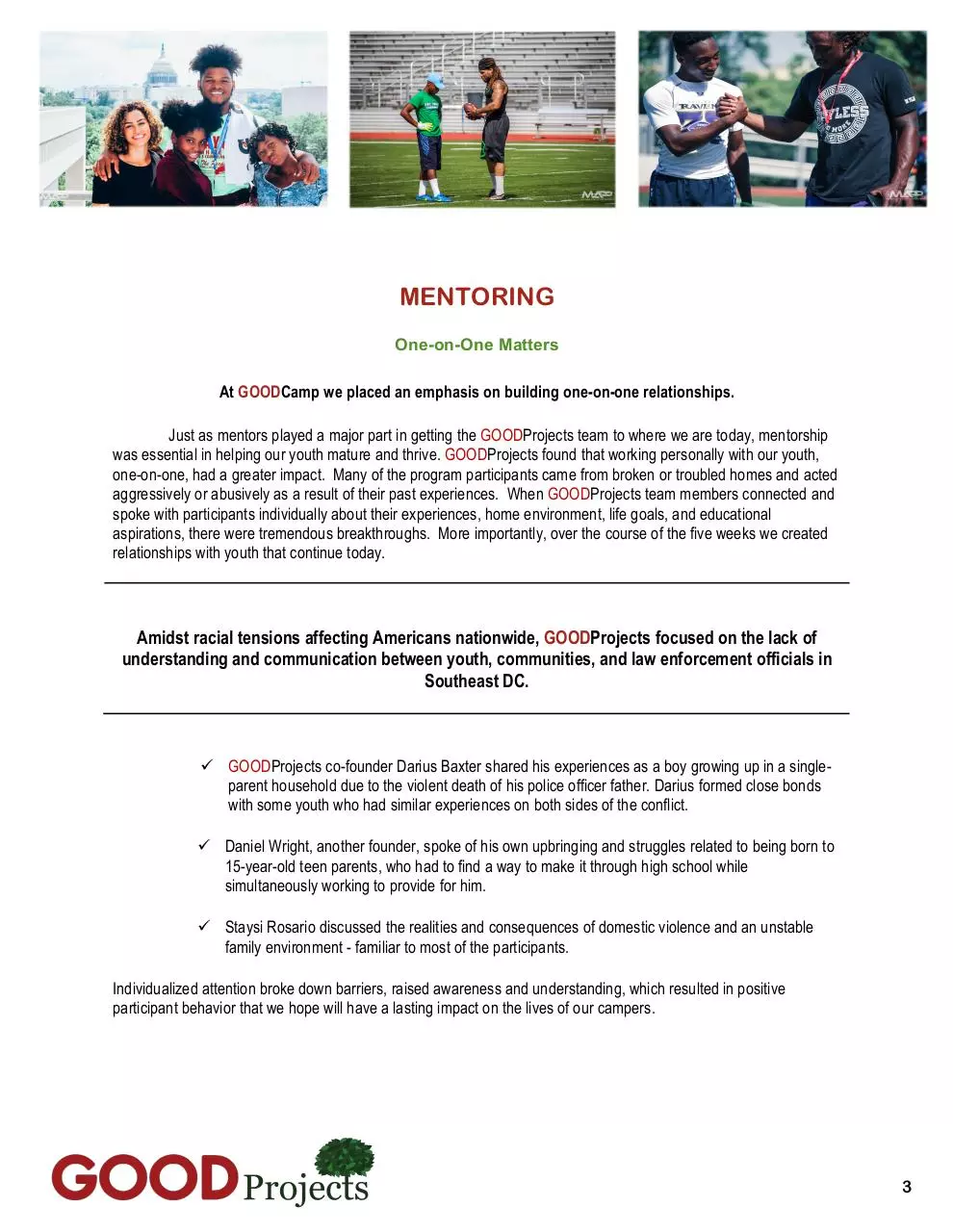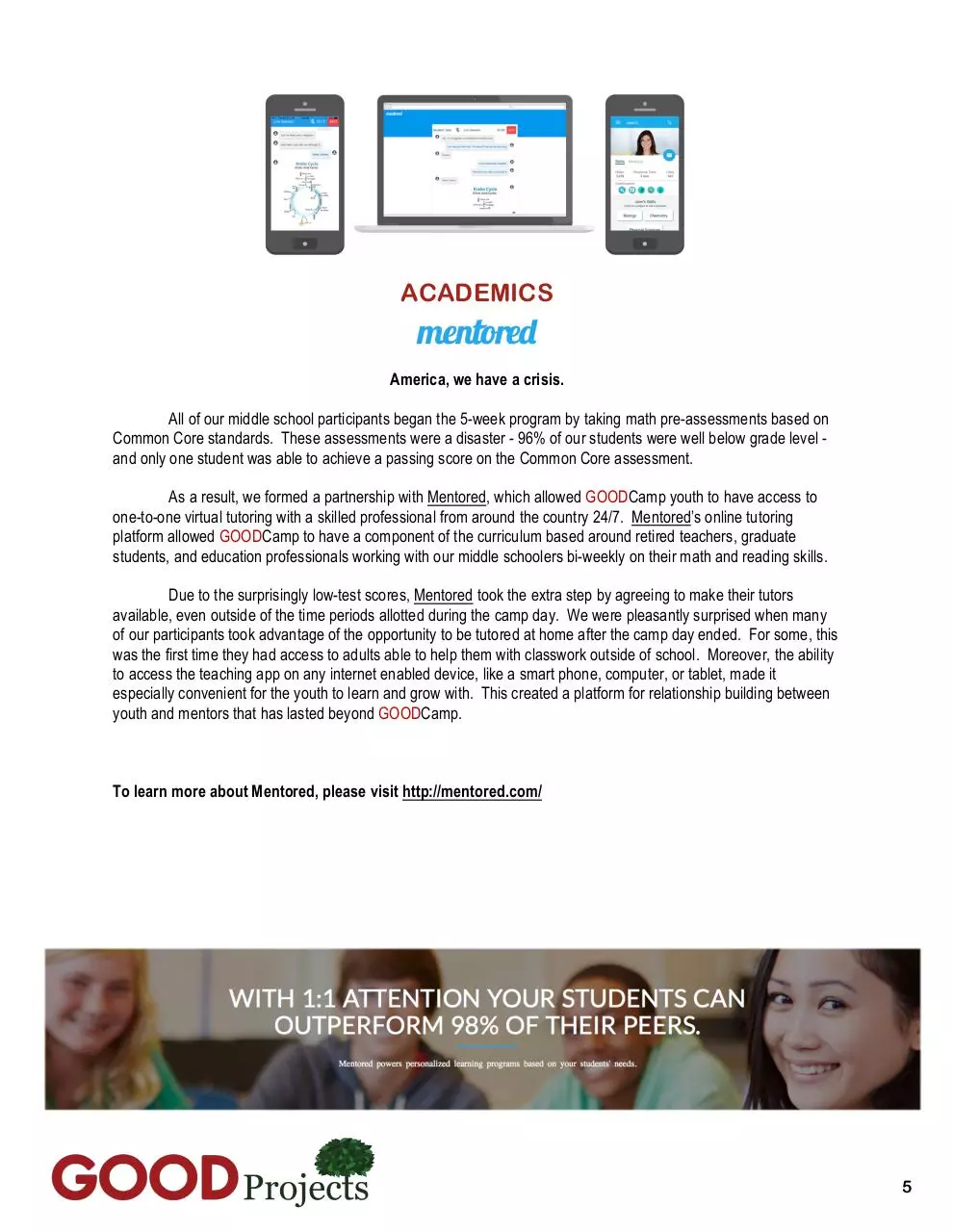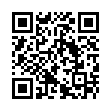GOODCamp White Paper (PDF)
File information
Title: Microsoft Word - White Paper Draft 2.docx
This PDF 1.3 document has been generated by Word / Mac OS X 10.11.6 Quartz PDFContext, and has been sent on pdf-archive.com on 07/11/2016 at 03:13, from IP address 65.222.x.x.
The current document download page has been viewed 506 times.
File size: 305.76 MB (10 pages).
Privacy: public file





File preview
CAMP
ATHLETICS | MENTORSHIP | ACADEMIC EXCELLENCE | ECONOMIC EXPOSURE |
SOCIAL ENTREPRENEURSHIP | HIGHER LEARNING
Presented by
GOODCamp 2016 Report
A Holistic Approach
It was a long, hot, violent summer in our Nation’s Capital.
Varying factors increased the number of homicides in Washington, DC by an unprecedented 54% in 2015.
Of the 1,183 crimes committed with guns in the first eight months of 2015, 428 occurred over the summer months of
June and July. DC was placed on high alert; 22 of 39 regional clusters of the city, including Anacostia, were
classified as hotbeds for violence because of the previous year.
As a result, GOODProjects, a newly formed organization combining the individual talents, charitable
activities and community involvement of three former Georgetown student-athletes, initiated our pilot summer
program, GOODCamp, to combat the rise of gun violence in DC. GOODCamp was created to provide a no cost,
crime-free, drug-free safe space for low-income youth, while helping them develop professionally,
academically, socially, and athletically. GOODCamp was able to get 150 youth off the streets and into lifechanging experiences that stretched their dreams, aspirations, and expectations outside of the Anacostia
borders by utilizing a specialized curriculum tailored specifically at low-income urban youth.
At its core, GOODCamp was created for low-income, urban youth in Wards 7 and 8 of Washington, DC,
where poverty, crime, and gun violence is at its highest. For five weeks, GOODCamp focused on six key aspects of
positive youth development: mentorship, academic excellence, physical activity, economic exposure, social
entrepreneurship, and higher learning. These were taught utilizing several learning strategies: mentorship, brainbased learning, one-to-one virtual tutoring, entrepreneurship training, athletics, workshops/seminars, and field trips
outside of Anacostia.
The mission was to implement an individualized program tailored towards developing the entire person
through guidance and exposure. All of these components were designed to address and reduce the specific barriers
our youth in Anacostia face in their daily lives. GOODCamp youth were constantly challenged to identify different
ways they could alter personal expectations of their lives and their community.
_______________________________________________________________________
The positive impact on the community by GOODCamp was undeniable:
ü No homicides over the 5-week duration.
ü A marked reduction in gun use. (One counselor and one camper survived gun-violence
incidents just prior to the camp.)
Going forward, GOODProjects will continue to provide opportunities for low-income, urban youth that will allow them
to live fulfilling lives, free from poverty, violence and disease.
Through strategic partnerships we are becoming better able to target the adverse effects of experiences such as
poverty, crime and gun violence, in order to develop personal coping strategies that will change negative patterns,
address the root causes, and help youth attain emotional and social well-being as they become adults. We will
continue to utilize different technologies to increase outcomes in the years to come.
Thank you for your continued support,
GOODProjects.
2
MENTORING
One-on-One Matters
At GOODCamp we placed an emphasis on building one-on-one relationships.
Just as mentors played a major part in getting the GOODProjects team to where we are today, mentorship
was essential in helping our youth mature and thrive. GOODProjects found that working personally with our youth,
one-on-one, had a greater impact. Many of the program participants came from broken or troubled homes and acted
aggressively or abusively as a result of their past experiences. When GOODProjects team members connected and
spoke with participants individually about their experiences, home environment, life goals, and educational
aspirations, there were tremendous breakthroughs. More importantly, over the course of the five weeks we created
relationships with youth that continue today.
Amidst racial tensions affecting Americans nationwide, GOODProjects focused on the lack of
understanding and communication between youth, communities, and law enforcement officials in
Southeast DC.
ü GOODProjects co-founder Darius Baxter shared his experiences as a boy growing up in a singleparent household due to the violent death of his police officer father. Darius formed close bonds
with some youth who had similar experiences on both sides of the conflict.
ü Daniel Wright, another founder, spoke of his own upbringing and struggles related to being born to
15-year-old teen parents, who had to find a way to make it through high school while
simultaneously working to provide for him.
ü Staysi Rosario discussed the realities and consequences of domestic violence and an unstable
family environment - familiar to most of the participants.
Individualized attention broke down barriers, raised awareness and understanding, which resulted in positive
participant behavior that we hope will have a lasting impact on the lives of our campers.
3
BRAIN-BASED LEARNING
The Avalon Advantage
GOODCamp was committed to applying best practices to managing youth’s behaviors.
But that commitment is hard to fulfill when dealing with 150 students from challenging backgrounds and widely
varying degrees of social awareness and personal interactive skills.
In this effort, we were happy to team with the Avalon Institute of Washington, DC to identify our youth’s
cognitive learning preferences. Working with our student’s learning preferences allowed us to better understand and
predict their responses to specific situations that may have occurred in their day-to-day experiences. Our youth
learned they had the ability to identify and manage some of their own disruptive behaviors by teaching them
strategies to use in their daily lives. This created a better learning environment for all students. Students also
showed greater confidence in the camp’s learning environment as a result of being aware of their own brain’s
preferences for absorbing and processing information. Students who participated with the Avalon Institute were more
confident and less frustrated in the classroom.
Halfway through the camp, representatives from the Avalon Institute had one-on-one consultation sessions
with our youth and their parents to explain their preferences in further detail. The Avalon Institute then provided
problem-solving techniques for both parents and youth based on their individual preferences. The impact on
personal behavior was almost immediate – and lasted throughout the camp.
Here is where it gets interesting… and truly impactful. Data showed that many of the youth attending the
camp are often high “movers”. This means that their learning and information retention is best achieved while
physically active. Based on the results, we tailored our scheduled activities to these preferences and assigned tasks
based on individual strengths and abilities – using physical exercises to stimulate their minds and then followed up
with classroom activities. This process proved to be highly effective, and advisors to DC Public Schools are now
analyzing our results.
To learn more about the Avalon Institute, please visit http://www.avalonleadership.com/
4
ACADEMICS
America, we have a crisis.
All of our middle school participants began the 5-week program by taking math pre-assessments based on
Common Core standards. These assessments were a disaster - 96% of our students were well below grade level and only one student was able to achieve a passing score on the Common Core assessment.
As a result, we formed a partnership with Mentored, which allowed GOODCamp youth to have access to
one-to-one virtual tutoring with a skilled professional from around the country 24/7. Mentored’s online tutoring
platform allowed GOODCamp to have a component of the curriculum based around retired teachers, graduate
students, and education professionals working with our middle schoolers bi-weekly on their math and reading skills.
Due to the surprisingly low-test scores, Mentored took the extra step by agreeing to make their tutors
available, even outside of the time periods allotted during the camp day. We were pleasantly surprised when many
of our participants took advantage of the opportunity to be tutored at home after the camp day ended. For some, this
was the first time they had access to adults able to help them with classwork outside of school. Moreover, the ability
to access the teaching app on any internet enabled device, like a smart phone, computer, or tablet, made it
especially convenient for the youth to learn and grow with. This created a platform for relationship building between
youth and mentors that has lasted beyond GOODCamp.
To learn more about Mentored, please visit http://mentored.com/
5
SOCIAL ENTREPRENEURSHIP
A Pathway to China
After hearing about the work we were doing with youth in DC, DIVVII, a non-profit organization based in
China, reached out to GOODProjects to find common ground for collaboration. Months of planning went into a
curriculum that paired our high school participants in Anacostia with high school students in Shanghai, China. The
partnership tasked both groups of students to work together to develop a business model by the end of GOODCamp
for a minimum viable product focusing on social entrepreneurship. The kicker was that the business had to target or
address an issue shared between youth in Anacostia and Shanghai. The youth in Anacostia and abroad in Shanghai
were coached through this intense curriculum by DIVVII mentors over the course of the five weeks.
Developing a Value Proposition for an enterprise that is both lucrative and socially impactful is not easy, yet
our camp participants excelled. Remember, for some of our campers, this was the first time in their lives that they
had been exposed to entrepreneurship. After completing the basis for their businesses models, participants were
required to build websites to display their businesses. This gave them experience with coding and marketing as well.
Connecting two groups of youth with widely different cultures and experiences, while battling a 12-hour time
zone difference was difficult. However; through a concerted effort spearheaded by the staff of DIVVII, the program
was a complete success. Our kids embraced the opportunity to develop business skills while also learning more
about the current economic shift to a global marketplace. At the end of the program all participants were presented a
certificate of completion by StartupHoyas: The Georgetown Entrepreneurship Initiative, through Georgetown
University’s McDonough School of Business.
Yes, football was the organizational and motivational driver of GOODCamp, but the ancillary academic
benefits were significant.
To learn more about DIVVII, please visit http://divvii.com/
and to learn more about StartupHoyas, please visit http://startuphoyas.com/
6
ATHLETICS
GOOD Communication
Our mission included a commitment to caring for the entire individual holistically, yet understanding our
target demographic, we emphasized sports to appeal to the more sports-conscious youth. GOODCamp served as
an effective mechanism to bridge the gap between academic and athletic development.
GOODProjects also refrained from using traditional community-wide marketing techniques such as
advertising and social media because our commitment was to specifically serve the under-served Anacostia
community. Working alongside Off My Block, a local non-profit, we went door-to-door within the Anacostia
community, building relationships to recruit kids for our “football camp.” Our efforts were clearly successful; on the
first day of camp, 200+ youth were waiting outside the field to sign up.
Football as the Draw
We made a commitment to providing football training of the highest caliber to our campers. To fulfill this, we
reached out to Joe Haden Sr.’s NFL level training facility Haden Sports & Performance to work with our youth.
Haden Sr. accepted the invitation, agreeing to donate his time and staff over the course of the five weeks.
In some ways, they became one of our most valuable business partnerships because Haden’s staff
embraced the opportunity to develop specific drills at the beginning of every week. On multiple occasions the entire
Haden staff came to lead the drills with our campers, critique their techniques, and sometimes even coordinate flag
football games with them.
These were not your typical weekend warriors. The Haden staff was comprised of current and former
college football players who were eager to share their experiences. Aside from the skill development piece, the camp
participants would often take the time to ask them questions about what it takes to make it to college. Candidly,
some of our campers could not believe the GOODProjects team members were once Division I athletes, so it was
effective for them to get a different perspective from the staff of Haden Sports & Performance who were frankly in a
little better shape than us. When players from Howard University and Georgetown University volunteered their time,
it also added a level of excitement that made the campers feel valued and special.
This ongoing interaction between campers and adults helped us to achieve our mission of showing our kids
tangible steps they could take on the field and in the classroom, to make it to college.
7
SPEAKERS
Different Experiences … Different Perspectives
Over the course of the five weeks, 17 experts in their various fields volunteered their time to speak with our
youth. The line-up included entrepreneurs, CEOs of major corporations, elected officials, community activists,
professional athletes and college coaches. The depth and breadth of experiences they brought were beyond our
wildest expectations. Many of our campers had never encountered a nationally successful adult, and these
conversations had a deep and powerful impact. But no one could have expected the speaker who would have the
most impact would be someone from the Anacostia community.
After a summer of police involved shootings of young black men and women, the Metropolitan Police
Department eagerly volunteered to be represented at the camp by sending Officer Medina to engage our youth -- for
several hours. When he first entered, the kids were openly hostile, screaming profanity and turning their backs to
him. Yet Officer Medina entered with a sense of calm and understanding. He went on to break the kids into smaller
groups in order to take the time to listen to their individual points of view, good or bad. In the end Officer Medina’s
approach created an environment of mutual respect that transcended and eventually broke down barriers. It allowed
our kids to engage with a police officer in a way none of them had experienced before. In the end race and
community were the topics of discussion, but the lessons our youth learned that day will carry forever.
One of our great camp success stories was the universal understanding that conflict only needs a little room
for communication to diffuse situations and bring people to common ground. The interaction between students and
the adults proved that regardless of positions of power, you are never too old to learn and never too young to teach.
8
FIELD TRIPS
Going Beyond Limits
Our fundraising goal was set to ensure the lessons we would be teaching were validated through tangible
activities supported by sponsored field trips. Thankfully through generous donations and a partnership with All
Seasons Transportation, this goal became a reality. Our youth were able to take trips to fun places such as the
Redskins’ Training Camp, the Newseum, and the Kingman Island nature preserve, among others - Georgetown
University, the Holocaust Museum, and Capitol Hill.
While the Redskins training camp was the most exciting experience for program participants, the Holocaust
Museum proved to be the most breathtaking. During the tour, our youth were exposed to the experiences of
individuals outside of their community. As a result, they gained a new perspective on local, national, and international
issues. They were very vocal about the shock and emotion experienced from this visit.
During our visit to Georgetown University, we learned that the majority of our youth had never been offered
the opportunity to visit the University, despite living only a few miles away from its campus. Georgetown’s head
football coach, Rob Sgarlata, took our youth on a campus tour of the academic and athletic facilities. After the tour, a
member of the Financial Aid Department spoke to our youth, welcoming them to campus grounds and explaining the
possible accessibility to scholarships offered to incoming accepted students.
9
Download GOODCamp White Paper
GOODCamp White Paper.pdf (PDF, 305.76 MB)
Download PDF
Share this file on social networks
Link to this page
Permanent link
Use the permanent link to the download page to share your document on Facebook, Twitter, LinkedIn, or directly with a contact by e-Mail, Messenger, Whatsapp, Line..
Short link
Use the short link to share your document on Twitter or by text message (SMS)
HTML Code
Copy the following HTML code to share your document on a Website or Blog
QR Code to this page

This file has been shared publicly by a user of PDF Archive.
Document ID: 0000504088.